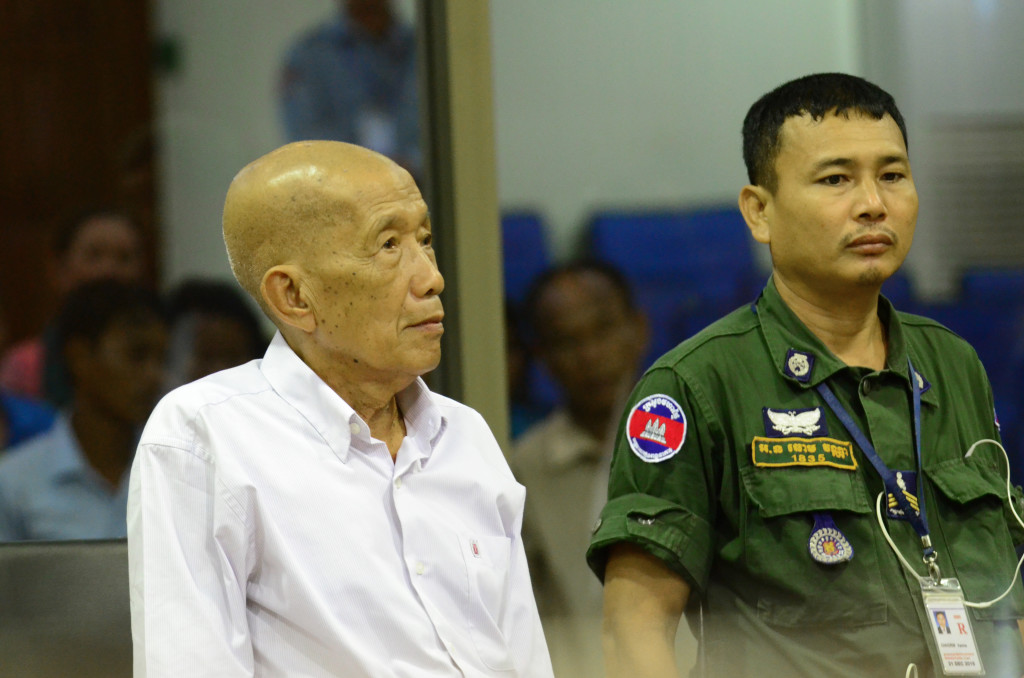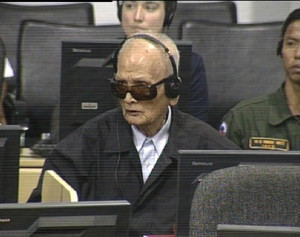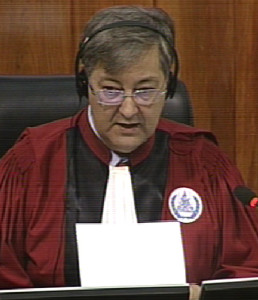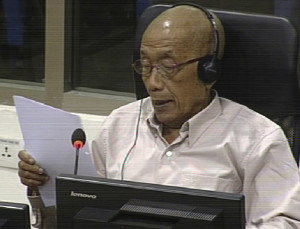Khmer Rouge ‘Internal Purges’ and Incriminations
Since his testimony started, former leader of S-21 Duch has incriminated Nuon Chea as well as Khieu Samphan in activities linked to S-21. He gave lengthy answers about the purges of cadres under the Khmer Rouge regime, including the common practice of removing the names of higher ranked officials from confessions. Notably, the witness recalled Nuon Chea ordering him to strike Khieu Samphan’s name from an incriminating document. In relation to this, Judge Jean-Marc Lavergne continued on this week’s theme and looked into the hierarchical structure of the party. Judge Lavergne’s line of inquiry was complex and perplexing at times.
Duch bears witness of incriminations in the Khmer Rouge
Judge Jean-Marc Lavergne started putting the witness through questioning yesterday, and kept asking about the internal purges and the role of Nuon Chea in taking names off incriminating lists. According to the witness, Ieng Sary’s son-in-law Poeun, who was a friend of Duch’s as well as in charge of a technical office after 1975, benefited this treatment on the order of Nuon Chea[1]. The witness said that reportedly, Son Sen said that Pheum, a Hanoi cadre, had incriminated Ros Nheum, alias Niang.
A Hanoi cadre, as explained Duch, was a cadre who had been sent to train in Vietnam and had joined the Communist Party of Vietnam after July 1954 (the end of the Indochina war). They were then called back by Pol Pot by 1971. There were roughly 1,700 cadres. Judge Lavergne asked when the purge of these cadres started: Duch could not remember, but knew some of them were sent to M-13, interrogated and smashed.
Duch looked carefully for the annotations Judge Lavergne was pointing to on the next document[2]. He recognized his own handwriting as well as Son Sen’s – he explained that after the confession went through him, Son Sen made his own suggestions and sent it to Committee 870, the Central Committee. These suggestions were not always carried out.
“Nuon Chea would instruct me to take out some names of implicated cadres from confessions; [that] was that done before the confessions were sent to the zones.”
There were a certain number of documents mentioning staff going from S-21 to other centers, as well as S-21 survivor Chum Mey’s testimony, in which he said Nho came from Phnom Penh with confessions and stayed at Okan Sey to interrogate people who had been implicated by other cadres[3]. Duch denied anyone from S-21 was authorized to go work elsewhere.
Alternating between confessions and the chain of command in his line of questioning, Judge Lavergne had the witness elaborate on certain situations. Duch answered that Lin and Pang were here as spokespersons of Phal when Nuon Chea was away[4] [5].
Posthumous photographs of prisoners
Once again, Duch said that Nuon Chea and Son Sen were the ones to order photographs of some of the prisoners, even though sometimes they were already dead. In this case, they would exhume the bodies.
“Pon used a knife to place on the neck of the dead prisoner”, Duch said, miming a blade on his own neck. “Then he took a picture.”
“Mr. Witness, you mentioned that pictures were taken of the bodies of Westerners – how is that possible, since you said they were burnt to ashes?”
“Pictures taken when their ankles were shackled ; executed before they were burnt.”
Duch said that on the other hand, his superiors were not interested in the number of prisoners at S-21. He himself was usually aware of the numbers, considering that sometimes there were to “make space for newcomers”, purges that Duch mentioned during his testimony yesterday. Based on his own knowledge, he said that at one day he counted, there were more than 10,000 prisoners since the beginning up the December 31, 1978. Towards the end of today’s testimony, witness Duch specified that Nuon Chea ordered him to kill the remaining prisoners on January 3, 1979.
The Cham people and the lasts days of S-21
The witness acknowledged, nodding, that he had gotten information about the removal of the Cham during his own trial and not at the time. Brother Nuon and Son Sen did not instruct him on massive executions of Cham people. Pheum did send him a telegram regarding the execution of the Cham.
Judge Lavergne then went back to talking about S-21 and questioned the witness on the last days before the Vietnamese troops arrived in Phnom Penh.
“Nuon Chea gave me the order to execute the remaining prisoners.”
The well-known S-21 photographs of the bodies remaining on metal beds, found when the Vietnamese arrived, were mentioned by Judge Lavergne: “Who was killed on those beds?” Duch answered that orders from the upper echelon had been given, and notably Nat executed four remaining prisoners.
Over a week ago, witness Suos Thy was asked if there had been an order to destroy the S-21 archives when the Vietnamese arrived in Phnom Penh. His failing memory did not provide an answer, and today Duch said there had been no such order by Nuon Chea. However, the witness said that Brother Hem, or Khieu Samphan, as well as Son Sen and Nuon Chea “scolded” him because he had not destroyed the documents at S-21.
Youk Chong, alias Chhon (director of the electricity power plant in Chak Angray, former Khmer Rouge) had implicated Khieu Samphan. Duch received the instruction from Nuon Chea to remove his name from the confession[6]. “When the Party did not want any names to be included, I removed the names”, Duch said. He also recalled Nuon Chea saying:
“Is everyone implicated in the C.I.A? Do you work correctly, or you will be sent to work in an Embassy.”
Relations between Democratic Kampuchea and Thailand
According to the witness, it happened that Cambodian prisoners were handed over by the Thai authorities, but he had no recollection of M-16, which the Judge specified[7]. Judge Jean-Marc Lavergne then proceeded in a lengthy dictation of documents related to Cambodian prisoners handed over by Thai authorities who were detained and executed at S-21[8].
Though Duch remembered that prisoners from Thailand, including Thai fishermen, were brought and executed at S-21, he did not recall how many there were added to the 1977 one documented here[9]. The order came from the upper echelon. The witness insisted that he should be able to compare these documents with the compiled list to conclude whether they were sent and executed at S-21.
Important prisoners and family ties to Nuon Chea
Judge Lavergne once again formulated an elongated list of documents in relation to the arrest, interrogation and execution of Lak Dara, alias Tan, her sister Lak Vari[10], alias Nan, and both their husbands (respectively Sat and Pik Hun, alias Yun)[11]. The first couple worked in Hospital 17, and the second at the Ministry of Foreign Affairs[12] [13]. Duch could not remember anything about who they were exactly and why they were arrested, except that they were Nuon Chea’s nieces. Lak Dara, alias Tan, was not executed because there were no instructions from Nuon Chea to kill her; Duch said he used her as a doctor. However, the two husbands as well Lak Vari, alias Nan was executed. Nan was pregnant.
S-21 operations and staff
After the break, Judge Lavergne asked if Nuon Chea had mentioned other suspicions of treasons in his family (notably his uncle, Sieu Engk), but Duch did not know any details about it.
One S-21 document showed a discrepancy between the number of prisoners to feed and the number of people at S-21.[14] Judge Lavergne was likely attempting to highlight the mistreatment of prisoners at S-21, but the witness clarified that the higher number included the staff and not only the prisoners.
At this moment, Co-Counsel for the Defense of Nuon Chea Victor Koppe raised to his feet with a question, but he was not able to mouth a word before Judge Lavergne told him that he would have time to examine the witness later.
Relying on yet another document, Judge Lavergne inquired about the escape and the suicide of some prisoners[15]. On point 6 of the document were listed methods used by some prisoners to commit suicide, among which were “hanging, cutting their wrists or their throat, and pretend to swallow screw”, which Duch qualified “a main concern” after “many incidents happened”. When a suicide did occur[16], Duch said:
“My task was to prevent the suicide of important prisoners so that confessions would not get cut off. […] Koy Thuon had his ankles chained to prevent attempted suicide, and special guards looked over him who would inform me of any incidents [through the phone].”
“When I went to see him, I simply smiled.”
Duch went deeper into details about the despair certain prisoners faced. After explaining how they dealt with suicide, he was confronted with a report on which there was an annotation by Hor saying that certain prisoners needed “to be fattened”. The witness argued that this meant that they were prisoners whose health needed to be maintained because they had not yet confessed. Judge Lavergne however, seemed to think that drawing a list implied that there may have been hunger strikes in the prison. Duch did not recall such protests. When asked if prisoners were forcibly fed, the witness denied it as well.[17] He nonetheless confirmed this example:
“Thuy beat [Huot, one of the prisoners on the list] and forced him to eat his own feces.”
Staffing numbers at S-21
One other document highlighted that Duch and Nat used different format to record entering and released prisoners at S-21. Duch assured however that prisoners were not released in the common sense of the word: they were smashed[18] [19]. Daily checklists of prisoners indicated numbers to Duch every day and allowed him to report to his superiors.[20]
This next section of the interrogation was characterized by going into detail into a great number of documents, which at times confused the witness[21] [22]. There were many pauses in the hearing as the witness had to be assisted in order to be able to look at the mentioned reports.
“I get lost looking through these various number of documents. Could you please repeat your question?”
Duch was still able to characterize a drop in the number of 706 prisoners in a few days (see footnote 21) as anticipating the arrival of a large number of additional prisoners: they had to “clear out space”. Moreover, Duch denied blood draws were performed at S-21, though several testimonies asserted otherwise.
“Die Angkar”
Judge Lavergne showed an image from the documentary film “Die Angkar”. The image was the red sign board with yellow characters that witness Suos Thy did not remember during his testimony[23]. It was translated into English as “constantly heighten the spirit of revolutionary vigilance; protect the nation, the revolution, the people and the party”. The witness explained that boards and signs were put up during celebrations of the anniversary of the Khmer Rouge victory (April 17, 1975) as well as the anniversary of the establishment of the party. He denied that this sign was at S-21 in a permanent manner.
Duch had never seen the “Log Book” or orange book shown in the documentary film (witness Suos Thy could not recall it clearly either)[24]. “My staff members kept the records”, he said.
There was little time left, and Judge Jean-Marc Lavergne promised to continue dealing with live surgeries performed at S-21 tomorrow, June 16th, when the hearing will resume at 9am.
[1] E1/54.1, 27/03/2012, at 11h53.
[2] E3/1581, at 00172999-173000 (KH), 00224083 (FR), 00822994-95 (EN).
[3] E3/407, at 00401318 (KH), 00406224 (EN).
[4] E3/3261. Nuon Chea traveled to China and Korea in 1978 – photographs in Beijing
[5] E3/199.
[6] E1/51.1 on page 95.
[7] E3/961, at 00090147 (KH), 0081275556 (FR).
[8] E3/961 and E3/2269, at 01010578-81 (KH), 00181640-641 (EN), 00869779 (FR).
[9] E3/8447, at 00288587 (KH), 00810091-92 (FR), 00784632-33 (EN).
E3/2231 (S-21 list).
E3/3858.
[10] E3/8539, 636 (EN).
[11] E3/1851, at 00079588 (KH), 002500783 (FR), 00759986-84 (EN). E3/1946 and E3/2213, at 00040035 (KH), 00887859 (FR), 00184006 (EN).
[12] E3/1557, at 00076349-00076373 (KH), 00768111-131 (EN), 00782159-76 (FR).
[13] Pik Hun, alias Yun, E3/1857, 00075059-560 (KH), 00764001, 00193545-55 (EN) and 00763677 (FR).
[14] E3/1848, at 00162476 (KH), 00193064 (EN), 00229039 (FR).
[15] E3/8386, at 0002637-40 (KH), 00521631-34 (EN), 00532733-36 (FR).
[16] E3/3181, at 00728980 (EN).
[17] E3/10077, at 01012991 (KH), 01245974 (EN).
E3/10087, at 01159473 (KH), 01245975 (EN).
[18] E3/9955-67, 55 at 01012143 (KH), 01249682 (EN).
[19] E3/9960.
[20] E3/9970, at 01012227 (KH). (8 May 1977)
[21] E3/10008, nb of prisoners 1,729, E3/10009, nb of prisoners 953.
[22] E3/10035.
E3/2285, at 00009094-9096 (KH), 00873193-201 (EN).
E3/9763. Prisoners from S-21 D (or K).
E3/8763. We find a number of persons removed: 5.
[23] E3/719, at 01248211 (EN). Die Angkar, minute 10”24.
[24] Die Angkar, 10”23 to 10”24”03.





[…] [5] See Khmer Rouge Internal Purges and Incriminations, The Cambodia Tribunal Monitor, June 15, 2016. […]